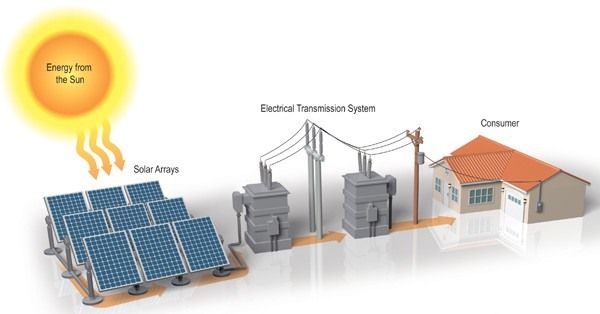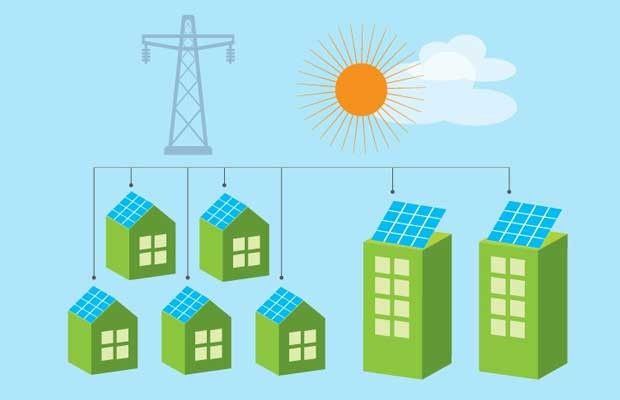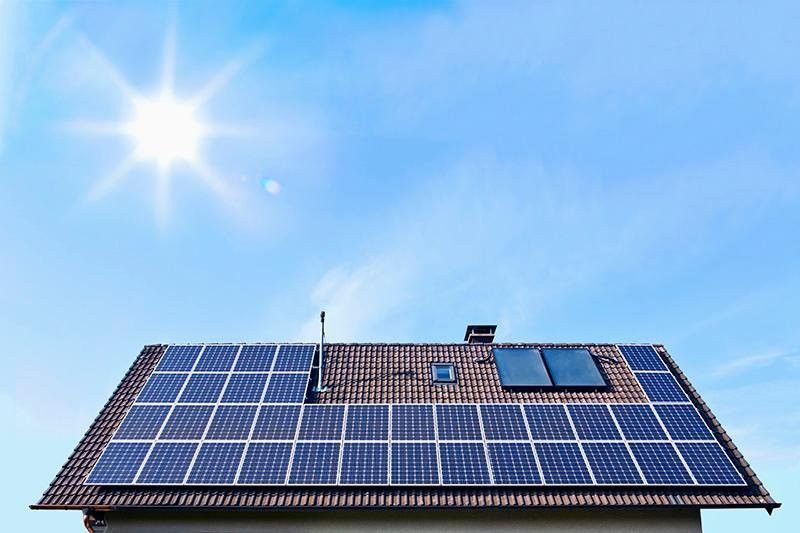How Is Solar Energy Produced And Distributed?

Overview:
Solar energy is defined as solar radiation that is capable of creating heat, activating chemical processes, or generating electricity. The overall quantity of solar energy incident on Earth much exceeds the world's present and projected energy needs. This widely distributed source has the ability to meet all future energy demands if properly exploited. Solar energy is predicted to become more appealing as a renewable energy source in the twenty-first century due to its unlimited supply, non-polluting nature and ease of panel installation and solar design , in contrast to the finite fossil fuels of coal, petroleum, and natural gas.
The Sun is an enormously strong energy source, and sunlight is by far the most important source of energy received by the Earth, although its intensity at the Earth's surface is rather modest. This is mostly due to the massive radial dispersion of radiation from the distant Sun. The Earth's atmosphere and clouds absorb or scatter up to 54 percent of the incoming sunlight, resulting in a comparatively small extra loss. The sunlight that reaches Earth contains roughly half visible light, half infrared radiation, and trace amounts of ultraviolet and other types of electromagnetic radiation.
The potential for solar energy is huge, since Earth receives around 200,000 times the world's entire daily electric-generating capacity in the form of solar radiation every day. Unfortunately, even though solar energy is free, the high cost of collecting, converting, and storing it restricts its use in many regions. Solar radiation may be transformed into either thermal energy (heat) or electrical energy, with the former being the simpler of the two.
How is Solar Energy Distributed on Earth?
The Earth's heat engine does more than just transmit heat from one section of the surface to another; it also moves heat back to space from the Earth's surface and lower atmosphere. This flow of entering and exiting energy is referred to as the Earth's energy budget. Clouds, atmospheric particles, and brilliant land surfaces such as sea ice and snow reflect roughly 29 percent of the solar energy that reaches the top of the atmosphere back into space.This energy has no effect on the Earth's climate system. Water vapor, dust, and ozone absorb around 23% of incoming solar energy, while the remaining 48% travels through the atmosphere and is absorbed by the earth. As a result, the Earth's system absorbs around 71% of all incoming solar energy.
The 340 watts per square meter of solar radiation that falls on Earth is reflected back into space by clouds, but also by other brilliant surfaces and the atmosphere itself. Approximately 23% of incoming energy is absorbed in the atmosphere by gasses, dust, and other particles. The remaining 48% is absorbed on the surface.
Because the Earth's atmosphere and surface absorb 71 percent of incoming solar radiation, they must radiate that much energy back to space in order for the planet's average temperature to stay steady. However, the proportional contributions of the atmosphere and the surface to each process (absorbing sunlight vs. emitting heat) are asymmetrical. The atmosphere absorbs 23% of incoming sunlight, while the surface absorbs the remaining 48%. The atmosphere radiates 59 percent of incoming sunlight, whereas the surface radiates just 12 percent. In other words, the majority of solar heating occurs at the surface, whereas the majority of radiative cooling occurs in the atmosphere. How does this energy reshuffling occur between the surface and the atmosphere?
What is Distributed Generation?
Distributed generation refers to a range of technologies that produce energy at or near where it will be utilized, such as solar panels and combined heat and power. Distributed generation may service a single building, such as a house or company, or it may be part of a microgrid (a smaller grid that is also hooked into the larger energy delivery system), such as at a significant industrial complex, a military post, or a large college campus. When linked to the electric utility's lower voltage distribution lines, distributed generation may assist in supporting the supply of clean, dependable power to new consumers and decrease energy losses along transmission and distribution lines.
Examples of Distributed Generation:
In Residential Sector:
- Solar photovoltaic panels
- Small wind turbines
- Natural-gas-fired fuel cells
- Emergency backup generators, usually fueled by gasoline or diesel fuel
In Commercial and Industrial Sectors:
- Combined heat and power systems
- Solar photovoltaic panels
- Wind
- Hydropower
- Biomass combustion or cofiring
- Municipal solid waste incineration
- Fuel cells fired by natural gas or biomass
- Reciprocating combustion engines, including backup generators, which are may be fueled by oil
Distributed Generation of Solar Power:
Distributed solar power generation is an approach to providing solar energy resources by deploying tools and technologies in proximity to the end users of the power. The power producing system may be mounted on the roofs of households and business buildings that will use the energy. This approach differs from centralized production, in which solar energy is generated by a huge facility and then supplied to users through the power grid. Furthermore, excess energy generated by private owners (through solar) may be sold to power corporations.

Rooftop solar is fast gaining popularity in India in comparison to other kinds of renewable energy sources because it is widely accessible and can be localized and customized to meet the demands of users. By the end of 2019, India's total solar rooftop installation capacity will have reached 4.4 GW.
Standard Setup of Distributed Solar Power Generation System:
Solar Panel:
The total solar irradiation at midday on a bright day varies depending on location, but only 15-20% of it gets turned into power by the solar panels. In order to generate enough energy in a day, polycrystalline or monocrystalline panels are put on roofs, open grounds, or walls with the front facing the sun.
Mounting Framework:
The mounting framework utilized for installation contributes to the unit's beauty. It is critical to ensure that the mounting structure is secure and that it complies with local government standards.
Storage Battery:
The solar irradiation received by the solar panels is stored in a series or parallel system of batteries, which supplies power as needed. The number of batteries needed and the capacity of each battery are determined ahead of time while keeping the 24 hour load pattern in mind.
Charge Controller:
The output of the panels fluctuates in response to changes in sun irradiation. A charge controller acts as an interface between the storage batteries and the panels, ensuring that the deep cycle batteries are not overcharged during the day and that power is not reversed to the solar panels overnight, draining the batteries. Maximum Power Point Transfer (MPPT) and Pulse Width Modulation (PWM) controllers are included in the system.

Inverter:
The electricity is still in direct current (DC) form, but the home outlets are in alternating current (AC). This is where the inverter comes in: it transforms the direct current (DC) of the batteries to alternating current (AC) for usage in domestic circuits. Switching arrangements are often used in inverters to manage power delivery to the load.
Advantages of Distributed Solar Power Systems:
- Energy is generated without the generation of hazardous waste.
- A low-cost solution that allows for more savings
- Transmission and distribution losses must be kept to a minimum.
- There is no need to utilize extra land.
- Systems that are modular, decentralized, and adaptable
- In the event of an emergency, there will be a backup grid.
- Simple to implement.
- easy to maintain.
- Less risk and greater savings
- Generates job opportunities
Conclusion:
Studies in recent years have proven that significant climate change is now inescapable and presents a huge danger to both mankind's daily existence and the planet around us. The way the world acquires energy is critical to how we solve this dilemma, and although there has been an urgent need to act, progress has been gradual and restricted in its effect so far.
Every day, more solar energy strikes the globe than the existing population can utilize in a year. Let us continue to work together to harness this immense power and put it to good use. With efficiency improving, costs dropping on a daily basis, and new technologies being tested, it will be fascinating to see where we are in the solar sector in the next few years. What do you believe the future will be like?

